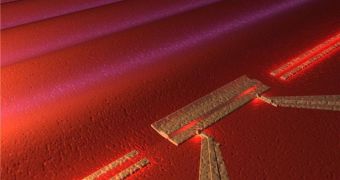In a paper published in the latest issue of the top scientific journal Nature Physics, experts from the Chalmers University of Technology (CUT) demonstrate a quantum microphone (noise detector) that can pick up extremely faint sounds.
The new paper could be of great use to physicists seeking to uncover new phenomena in quantum physics. The device is destined specifically to detect the level of quietness that is characteristic to quantum mechanics.
In the future, the team explains, it may become possible to create an entirely new class of quantum hybrid circuits, which would combine electrical and acoustic elements. This would, in turn, enable them to underlie a wider range of practical applications.
CUT investigators say that a single electron transistor is all that's needed to construct the new quantum microphone. Through this transistor, they explain further, electrical current can only flow one electron at a time, Science Daily reports.
The detector works by figuring out when acoustic waves pass above it. Even though the wavelength of the actual waves is extremely small – just 3 micrometers across – the device is even smaller, allowing it to detect any changes with extreme speed.
This is mostly what makes it so sensitive. The instrument is even outfitted with an echo chamber, though the latter is only three millimeters long. What is very interesting to note here is that the speed of the sound the microphone measures is roughly 10 times faster than that of air.
The microphone is sensitive only to a few types of sound waves, i.e. those that are quiet enough to be governed by the laws of quantum mechanics, rather than those of classical physics. The device operates best at sound wave frequencies of about 1 gigahertz.
The human ear can hear frequencies up to 22 or 24 kilohertz. The sound targeted in this study is therefore many times higher than what we could ever hear. In musical terms, it's 21 octaves above one-lined A.
“The experiment is done on classical acoustic waves, but it shows that we have everything in place to begin studies of proper quantum-acoustics, and nobody has attempted that before,” PhD Student and first study author, Martin Gustafsson, explains.

 14 DAY TRIAL //
14 DAY TRIAL //